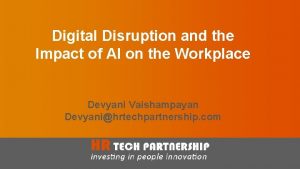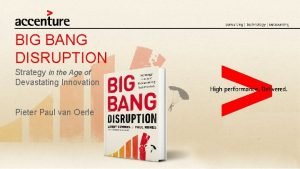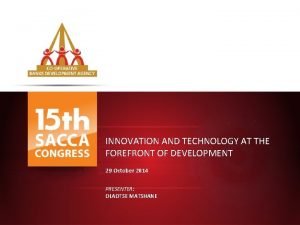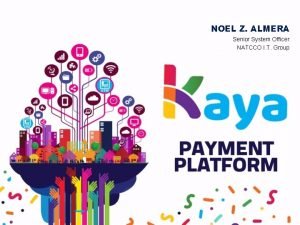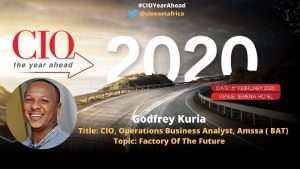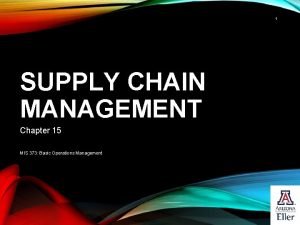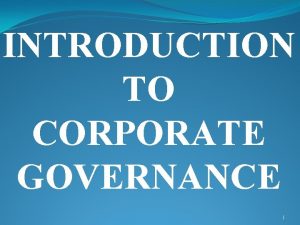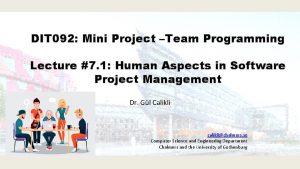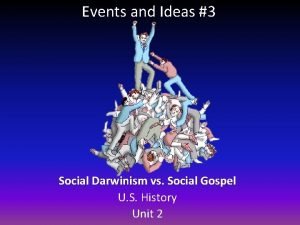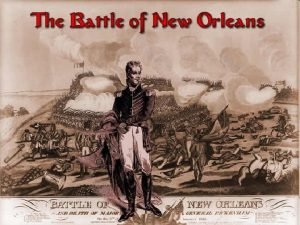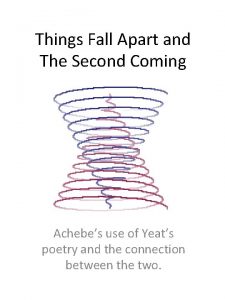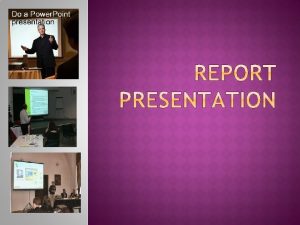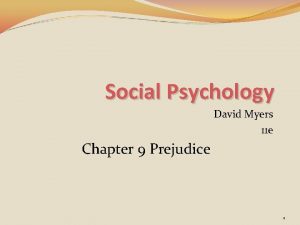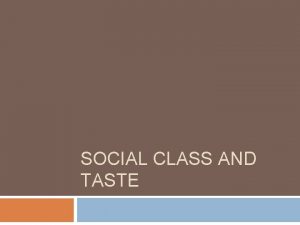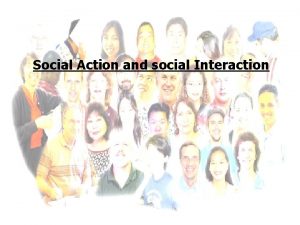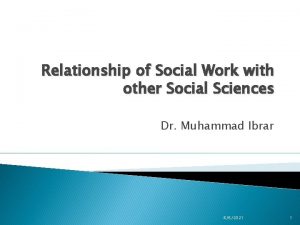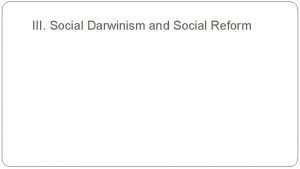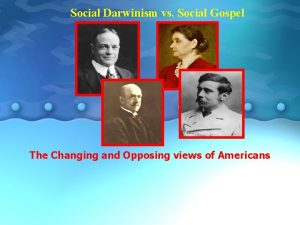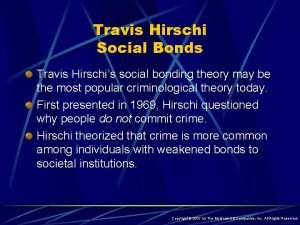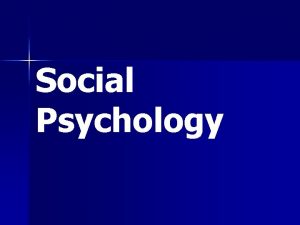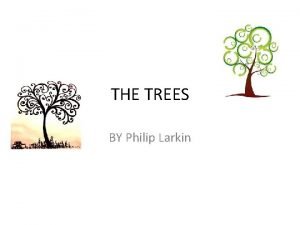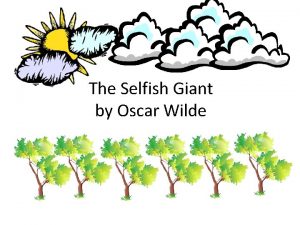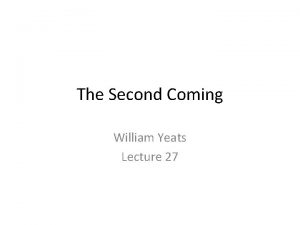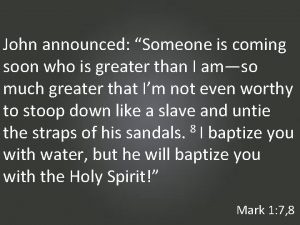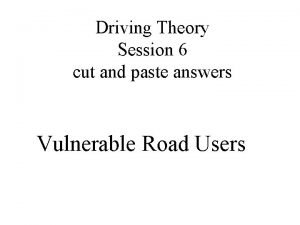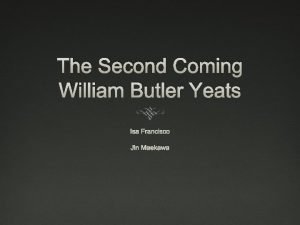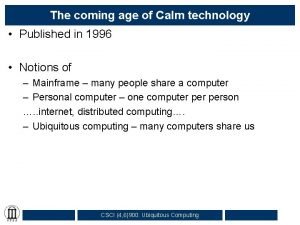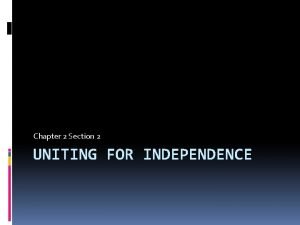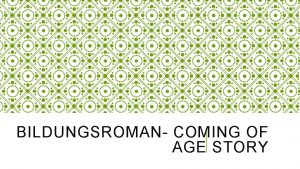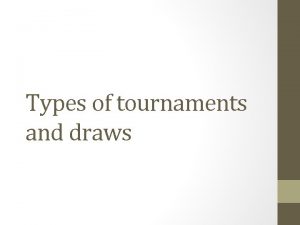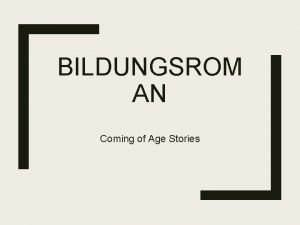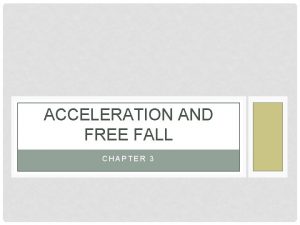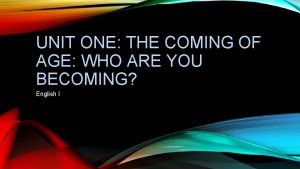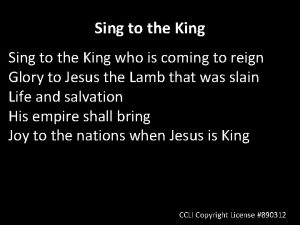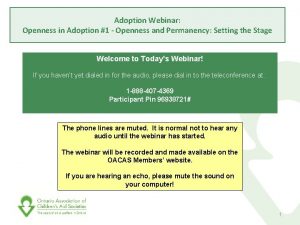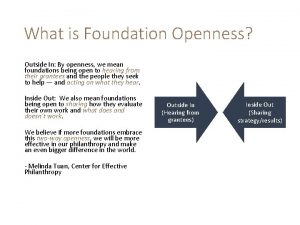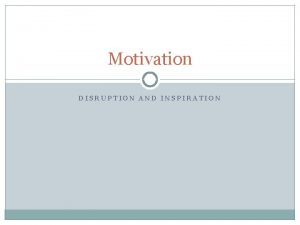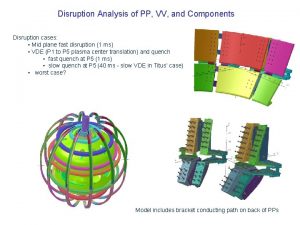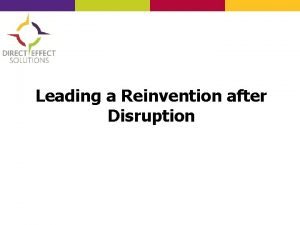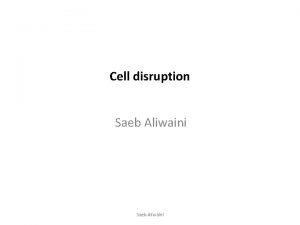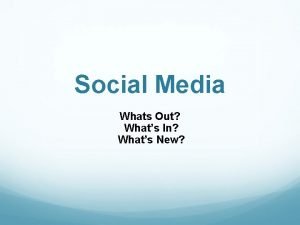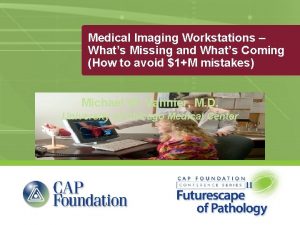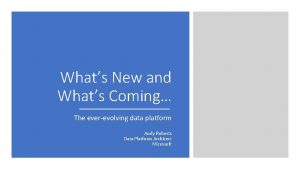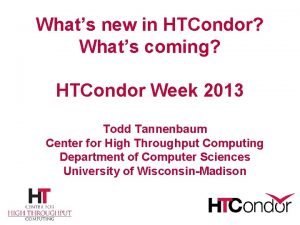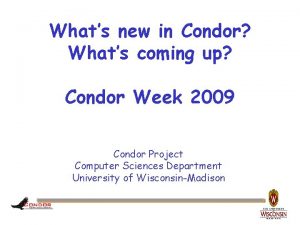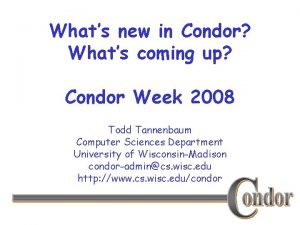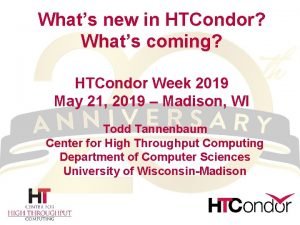Whats Coming Disruption Openness and Social Production David
















































































- Slides: 80

What’s Coming: Disruption, Openness, and Social Production David Lewis August 21, 2013 Grand Valley State University © 2013 David W. Lewis. This work is licensed under a Creative Commons Attribution-Non. Commercial-No. Derivs 3. 0 Unported License.



Libraries After Disruption 1. Informal Learning Spaces 2. Librarians as experts in all aspects of scholarly communication 3. Curate local content for the world 4. Just-in-time delivery rather than inventories as the core strategy for delivering content

“The moment we are living through, the moment our historical generation is living through, is the largest increase in expressive capacity in human history. ” Clay Shirky, How social media can make history, TED Talk, June 2009. Available at: http: //www. ted. com/talks/clay_shirky_how_cellphones_twitter_facebook_can_make_history. html




55425 Craft House 40 Division Ave S

Resulted in: 1. Novels as a literary form 2. Scientific journal 3. Use of alphabetical order as an organizing principle

Resulted in: 4. Literacy becoming an amateur activity 5. Scribal culture disappearing

Agenda 1. Disruption 2. Openness 3. Social productivity 4. Examples – Open textbooks – MOOCs

1. Disruption

What is Disruption? • New technologies and new business models replace old technologies • Creative destruction • Disruption is the means by which products and services get faster, easier, and cheaper

Disruption Clayton Christensen

Disruption The Innovator's Prescription: A Disruptive Solution to the Healthcare Crisis 1: 27 minutes, available at: http: //video. mit. edu/watch/theinnovators-prescription-a-disruptive-solution-to-the-healthcarecrisis-9380/ Clayton Christensen Available at: http: //www. americanprogress. org/issues/labor/report/2011/02/ 08/9034/disrupting-college/

Disruption • The capacity for customers to use new products and features increases, but at a slow rate • Products improve faster than customers can use the improvements • Products that were initially not good enough become too good

ures at cts or fe u d o r p w o use ne t y t i l i b rs a e Custom Time

t c u rod P e ures at cts or fe u d o r p w o use ne t y t i l i b rs a e Custom v o r p t Im n me Time

t c u rod Undershot Customer v o r p t Im e P ures at cts or fe u d o r p w o use ne t y t i l i b rs a e Custom n me Overshot Customer Time

Disruptive Innovation • Undershot Customer – Wants and will pay new features – Where money can be made • Overshot Customer – Doesn’t care about new features – performance oversupply – Basis of competition changes – Wants product to be cheaper, faster, easier – Commoditization

t c u rod P e ures at cts or fe u d o r p w o use ne t y t i l i b rs a e Custom v o r p t Im n me Time

t c u rod v o r p t Im P e ures at cts or fe u d o r p w o use ne t y t i l i b rs a e Custom n me ers New Us Time

Disruptive Innovation • Starts off as not being good enough for established customers so they don’t care about the product • Often creates a new group of users who did not have the time, expertise, or money to use the established product • Begins by competing against nonconsumption — a poor product is better than nothing

Disruptive Innovation • Needs – New Technology (simplified solution) – Business Model (job to be done) – New Value Chain • How products become cheaper, faster, and easier

Disruptive Innovation • Established firms cram innovation into existing business model • Established firms retreat up market – Serving more sophisticated segment – This strategy runs out

Job to Be Done • We “hire” products and services to accomplish the jobs that need doing in our lives • “The customer rarely buys what the business thinks it sells him. ” — Peter Drucker Clayton Christensen: Milkshakes - Understanding the Job. Available at: https: //www. phoenix. edu/lectures/claytonchristensen/milkshakes-understanding-the-job. html

Why can’t established firms adapt to disruptive innovations?

Business Models Value Proposition A product that helps customers do more effectively, conveniently, and affordably a job they’ve been trying to do

Business Models Value Proposition A product that helps customers do more effectively, conveniently and affordably a job they’ve been trying to do Resources People, technology, products, facilities, equipment, and cash that are required to deliver this value to customers

Business Models Processes Ways of working together to address recurrent tasks in a consistent way: training, development, budgeting, planning, etc. Value Proposition A product that helps customers do more effectively, conveniently and affordably a job they’ve been trying to do Resources People, technology, products, facilities, equipment and cash that are required to deliver this value proposition to customers

Business Models Profit Formula/Values Assets and fixed cost structure, margins, professional values, career paths, etc. Value Proposition A product that helps customers do more effectively, conveniently and affordably a job they’ve been trying to do Processes Ways of working together to address recurrent tasks in a consistent way: training, development, budgeting, planning, etc. Resources People, technology, products, facilities, equipment and cash that are required to deliver this value proposition to customers

Business Models Profit Formula/Values Assets and fixed cost structure, margins, professional values, career paths Value Proposition A product that helps customers do more effectively, conveniently and affordably a job they’ve been trying to do Processes Ways of working together to address recurrent tasks in a consistent way: training, development, budgeting, planning, etc. Resources People, technology, products, facilities, equipment and cash that are required to deliver this value proposition to customers

The Innovator’s Dilemma Choice: 1. Better product for our best customers, better margins, enhances status of current employees 2. Crummy product that none of our current customers want, worse margins, puts current employees at risk

The Innovator’s Dilemma • Established values make in nearly impossible for organizations to create disruptive innovation • Separation is the only strategy that works • Firms that survive sacrifice business units that don’t

Business Models Types: 1. Solution shops — Consulting Firms 2. Value-adding process businesses — Factories 3. Facilitated user networks — Facebook, e. Bay, Angie’s List

Furthermore, what we see when we examine the existing institutions of higher education through this lens is that for decades now they have offered multiple value propositions around knowledge creation (research), knowledge proliferation and learning (teaching), and preparation for life and careers. They have as a result become conflations of the three generic types of business models—solution shops, value-adding process businesses, and facilitated user networks. This has resulted in extraordinarily complex —some might say confused—institutions where there are significant coordinative overhead costs that take resources away from research and teaching. A typical state university today is the equivalent of having merged consulting firm Mc. Kinsey with Whirlpool’s manufacturing operations and Northwestern Mutual Life Insurance Company: three fundamentally different and incompatible business models all housed within the same organization. Clayton Christensen, Michael B. Horn, Louis Caldera, Louis Soarse, Disrupting College: How disruptive innovation can deliver quality and affordability to postsecondary education, Center for American Progress, February 2011. Available at: http: //www. americanprogress. org/issues/labor/report/2011/02/08/9034/disrupting-college/

2. Openness

Openness • Open-access (OA) literature is digital, online, free of charge, and free of most copyright and licensing restrictions. • OA removes price barriers (subscriptions, licensing fees, pay-per-view fees) and permission barriers (most copyright and licensing restrictions). Peter Suber, Open access overview, at: http: //legacy. earlham. edu/~peters/fos/overview. htm


Pace of Substitution of Direct Gold OA for Subscription Journals 100. 0% 90. 0% 80. 0% 70. 0% 60. 0% 50. 0% 40. 0% 30. 0% 20. 0% 10. 0% 20 00 20 01 20 02 20 03 20 04 20 05 20 06 20 07 20 08 20 09 20 10 20 11 20 12 20 13 20 14 20 15 20 16 20 17 20 18 20 19 20 20 20 21 20 22 20 23 20 24 20 25 0. 0% Laakso, et. al. Estimates S-curve Extrapolation Based on 2000 -2009 S-curve Extrapolation Based on 2005 -2009 David W. Lewis, The inevitability of open access, College & Research Libraries, September 2012. Available at: http: //crl. acrl. org/content/73/5/493. full. pdf+html






Openness • • Alternative business model Uses digital distribution — marginal cost = $0 Cost paid up front in a variety of ways Product given away – Worldwide market – Eliminate most costs associated with the customer

3. Social Production

Social Production 1. Cost of coordinating groups has collapsed and organizations are no longer required to get things done 2. Ownership of the means of production is broadly distributed



In 2008, University of Washington scientists released the game Foldit hoping a sort of critical mass of gamers would mess around with proteins and, in the process, uncover some of their intrigue… and principal investigator Zoran Popovic said that some 60, 000 people worldwide had taken on the challenge… Well, now Foldit is officially more than just a neat idea. In a matter of 10 days, gamers were able to do what biochemists have been trying to do for a decade: decipher the structure of a protein called retroviral protease, an enzyme that is key to the way HIV multiplies. http: //news. cnet. com/8301 -27083_3 -20108365 -247/foldit-game-leads-to-aids-research-breakthrough/#ixzz 1 Ymvvz. ADV


Social Production • Technology allows for the creation of social capital • Works at world scale

Social Production • Cooperation is built into the infrastructure • One-time contributors and small contributions matter • In some cases more efficient than markets or firms

“We are use to living in a world where little things happen for love and big things happen for money. Love motivates people to bake a cake and money motivates people to make an encyclopedia. Now, though, we can do big things for love. ” Clay Shirky, Here comes everybody: The power of organizing without organizations, New York: Penguin Press, 2008, page 104.

= 100 million hours of thought

= trillion hours a year “Cognitive Surplus”



So, social production is a real fact, not a fad. It is the critical longterm shift caused by the Internet. Social relations and exchange become significantly more important than they ever were as an economic phenomenon. In some contexts, it's even more efficient because of the quality of the information, the ability to find the best person, the lower transaction costs. It's sustainable and growing fast. Yochai Benkler, The new open-source economics, ” TED Talk, July 2005. Available at: http: //www. ted. com/talks/yochai_benkler_on_the_new_open_source_economics. html

Example 1: Open Textbooks

Open Textbooks • The textbook market is a mess — nobody is happy • Open textbooks exist but they are not widely used 1. Faculty don’t change textbooks without reason 2. Many open textbooks are not well know or well regarded

Open Textbooks “A widely used industry estimate for the average investment to create the master copy of a college textbook is $750, 000. ” Joseph Esposito, Why are college textbooks so expensive? ” Scholarly Kitchen, October 10, 2012. At: http: //scholarlykitchen. sspnet. org/2012/10/10/why-are-college-textbooks-so-expensive/

Open Textbooks • Open means you have to pay for the product before publication and then give it away • How do you find $750 K with no revenue stream? 1. Do it at scale — large university consortium or professional association 2. Governments

September 27, 2012 Governor Jerry Brown signed legislation that will provide for the creation of free, openly licensed digital textbooks for the 50 most popular lower-division college courses offered by California colleges. In addition to making the digital textbooks available to students free of cost, the legislation requires that print copies of textbooks will cost about $20.

Open Textbooks • Current efforts are cramming open textbooks into existing business models • Not a money problem, rather it is a coordination problem • Needs social production solution

Example 2: MOOCs

MOOCs

MOOC poster, April 4, 2013 by Mathieu Plourde licensed CC-BY on Flickr at: http: //www. flickr. com/photos/mathplourde/8620174342/sizes/l/in/photostream/

t c u rod v o r p t Im P e ures at cts or fe u d o r p w o use ne t y t i l i b rs a e Custom n me ers New Us Time

MOOCs Disruptive Innovation 1. New technology 2. New business model 3. Not yet good enough for traditional users

MOOCs Disruptive Innovation 4. Competitive advantages • Scale — Can be cheaper • Analytics — Faster Improvement • Social Productivity — Can leverage user/student community

“This isn’t because massive online classes are the future tout court, or because scale is the only way to bring cost and value into acceptable balance—neither is true—but because they are the first practical alternative to college classes as a way of learning complex things cheaply. ” Clay Shirky, MOOCs and economic reality, Chronicle of Higher Education, July 8, 2013. Available at: http: //chronicle. com/blogs/conversation/2013/07/08/moocs-and-economic-reality/

“As with other inventions that produced an inferior product at a much lower price, from the printing press to the steam-driven loom to Wikipedia, what happens now is largely in the hands of the people experimenting with the new tools, rather than defending themselves from them. ” Clay Shirky, MOOCs and economic reality, Chronicle of Higher Education, July 8, 2013. Available at: http: //chronicle. com/blogs/conversation/2013/07/08/moocs-and-economic-reality/

MOOCs • Are we prepared to disrupt ourselves? • Are we prepared to commoditize our own expertise? • One like way for higher education to become faster, cheaper, and easier

• Georgia Tech to offer masters in computer science with MOOC technology for $6, 600 (on campus price is $45, 000) • Year 1 program budget $3. 1 million, expect $240 K in profits • Year 3 expectation $14. 3 million budget, $4. 7 million in profits • AT&T contributing $2 million, they will use the program to train employees and find potential hires Master’s degree is new frontier of study, New York Times, August 17, 2003. Available at: http: //www. nytimes. com/2013/08/18/education/masters-degree-is-new-frontier-of-study-online. html? pagewanted=1

“Families and taxpayers can’t just keep paying more and more into an undisciplined system where costs just keep on going up and up. We’ll never have enough loan money, we’ll never have enough grant money, to keep up with costs that are going up 5, 6, 7 percent a year. We’ve got to get more out of what we pay for. ” President Barack Obama, Remarks by the President on the Economy -- Knox College, Galesburg, IL, July 24, 2013. Available at: http: //www. whitehouse. gov/the-press-office/2013/07/24/remarks-president-economy-knox-college-galesburg-il

“That is what real revolutions are like. The old stuff gets broken faster than the new stuff is put in its place. ” Clay Shirky, Newspapers and thinking the unthinkable, March 2009. Available at: http: //www. shirky. com/weblog/2009/03/newspapersand-thinking-the-unthinkable/

Questions/Comments © 2013 David W. Lewis. This work is licensed under a Creative Commons Attribution-Non. Commercial-No. Derivs 3. 0 Unported License.
 Alur proses produksi
Alur proses produksi Disruptive selextion
Disruptive selextion Pengertian digital disruption
Pengertian digital disruption Big bang disruption examples
Big bang disruption examples From long disruption remained
From long disruption remained Millennial disruption index
Millennial disruption index Millennial disruption index
Millennial disruption index Accelerated disruption
Accelerated disruption Mis supply chain management
Mis supply chain management Importance of corporate governance
Importance of corporate governance Siemens openness
Siemens openness Openness personality trait
Openness personality trait Scrum value openness
Scrum value openness Canyouunit
Canyouunit Social thinking and social influence
Social thinking and social influence Social thinking social influence social relations
Social thinking social influence social relations Whats hot whats not
Whats hot whats not Social darwinism paralleled the economic doctrine of
Social darwinism paralleled the economic doctrine of In 1817 we took a little trip
In 1817 we took a little trip The second coming things fall apart
The second coming things fall apart Return of the king jesus
Return of the king jesus Thank you for coming here today
Thank you for coming here today Spring is here the sky is blue
Spring is here the sky is blue Are sore breasts and cramps a sign of pregnancy
Are sore breasts and cramps a sign of pregnancy Self-perpetuating prejudgments
Self-perpetuating prejudgments Whats social class
Whats social class Social action vs social interaction
Social action vs social interaction Relation of social work with other social sciences
Relation of social work with other social sciences Social thinking and social influence in psychology
Social thinking and social influence in psychology What was reform darwinism?
What was reform darwinism? Social darwinism and social gospel venn diagram
Social darwinism and social gospel venn diagram Social darwinism vs social gospel
Social darwinism vs social gospel Global agenda for social work and social development
Global agenda for social work and social development Social bonding theory
Social bonding theory Social thinking theory
Social thinking theory Coming down the pike
Coming down the pike The trees poem by philip larkin
The trees poem by philip larkin Simile definition
Simile definition Where did the children come from every afternoon
Where did the children come from every afternoon When was the second coming published
When was the second coming published The coming kingdom andy woods
The coming kingdom andy woods Who sings something's coming in west side story
Who sings something's coming in west side story What is the final stage of the coming together process
What is the final stage of the coming together process Holy spirit coming down
Holy spirit coming down Mine eyes have seen the glory of the coming of the lord
Mine eyes have seen the glory of the coming of the lord Lower- end media users
Lower- end media users Someone is coming soon
Someone is coming soon Jesus is coming soon revelation
Jesus is coming soon revelation Sundays coming
Sundays coming I lift my hand to the coming king
I lift my hand to the coming king The trees by philip larkin
The trees by philip larkin How will a school crossing patrol signal you to stop?
How will a school crossing patrol signal you to stop? Coming of age themes
Coming of age themes Beowulf summaries by section
Beowulf summaries by section Thematic statement examples
Thematic statement examples The second coming tone
The second coming tone The coming kingdom andy woods
The coming kingdom andy woods The coming age of calm technology
The coming age of calm technology Lesson note on the coming of the holy spirit
Lesson note on the coming of the holy spirit Jesus is coming soon
Jesus is coming soon Bruce dawe homecoming
Bruce dawe homecoming Joining us today
Joining us today Chapter 2 lesson 2 uniting for independence answer key
Chapter 2 lesson 2 uniting for independence answer key Elements of a coming of age story
Elements of a coming of age story Guided reading activity chapter 5 lesson 3 answers
Guided reading activity chapter 5 lesson 3 answers Who may abide the day of his coming
Who may abide the day of his coming Types of tournament and examples
Types of tournament and examples Preparation for the second coming
Preparation for the second coming Thank you for coming to my open house
Thank you for coming to my open house Signs of the second coming
Signs of the second coming Nanosystem fabrication facility
Nanosystem fabrication facility When is jesus coming to earth again
When is jesus coming to earth again An coming
An coming Edgetho beowulf
Edgetho beowulf A tennis player on serve tosses a ball straight up
A tennis player on serve tosses a ball straight up Abide the return
Abide the return Welcome thank you for coming
Welcome thank you for coming Coming of age unit
Coming of age unit Summer holidays are coming
Summer holidays are coming Jesus second coming
Jesus second coming Sing to the king who is coming to reign
Sing to the king who is coming to reign


